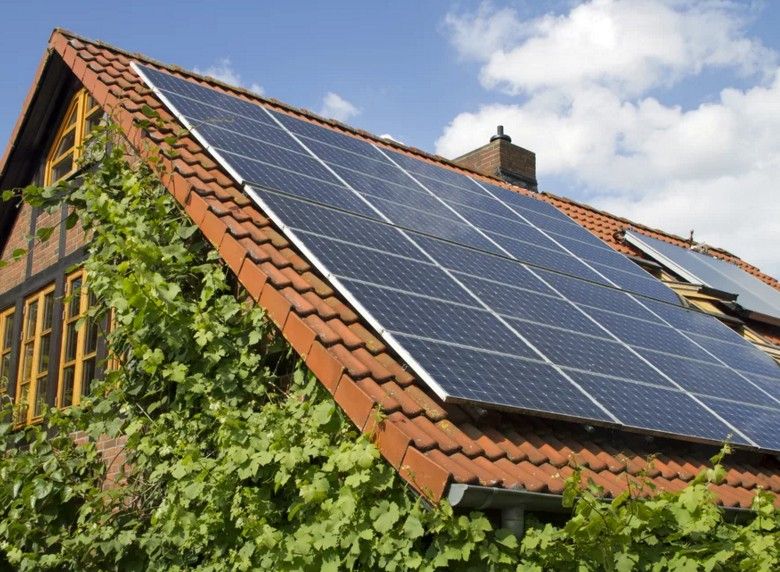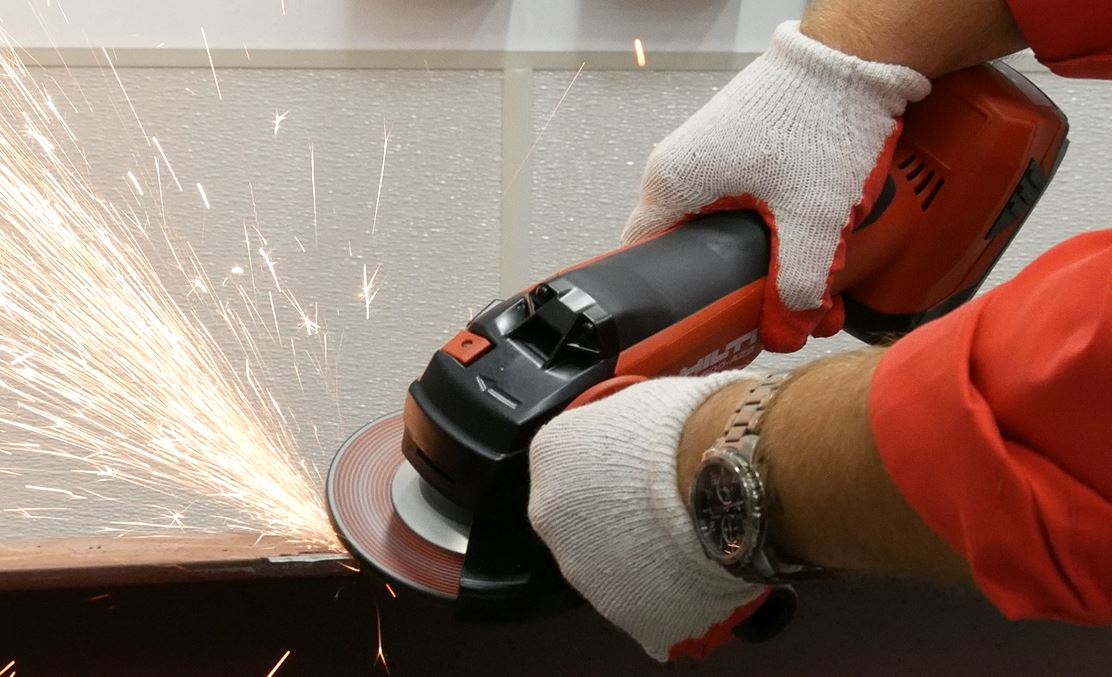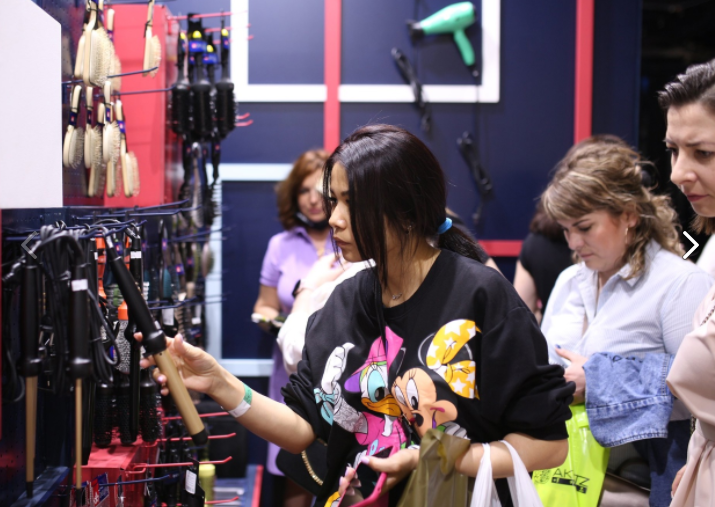Rating of the best electric underfloor heating in 2025
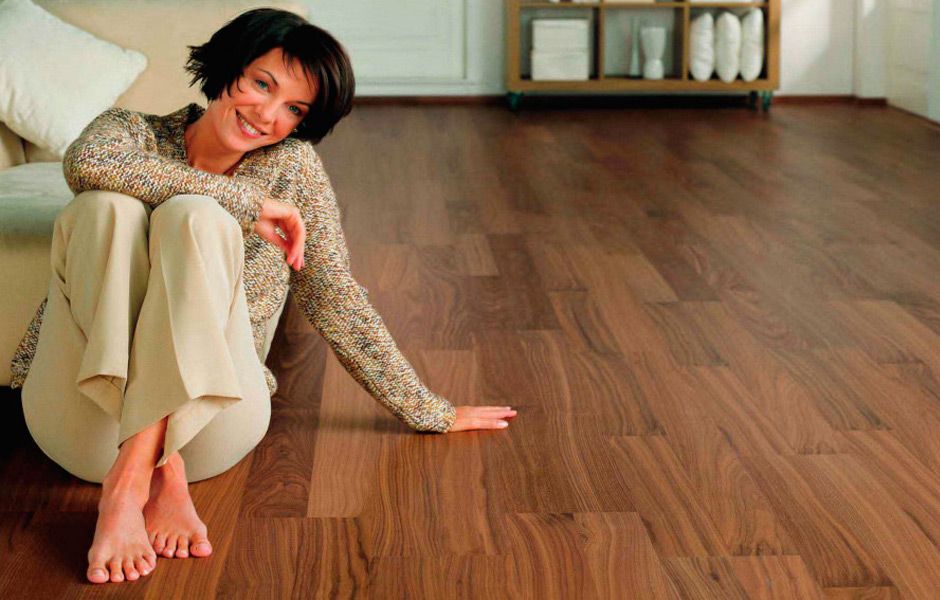
Everyone strives to make their home comfortable and cozy. Comfort, first of all, is associated with warmth. Warming up, we feel protected from all the hardships that are left outside the door. True, the classic heating system does not always meet our needs: it simply does not work in the off-season, and in the cold season it cannot provide full heat in every corner of the apartment. This shortcoming is completely solved by installing a warm floor.
Consider what are electric underfloor heating, and figure out which one is the best.
Content [Hide]
Varieties of electric underfloor heating
All electric heated floors are divided into three groups:
- cable;
- heating mats;
- film.
Let's see what is the peculiarity of each variety separately.
Cable underfloor heating
This is the very first, but not lost its relevance at the present time, type of underfloor heating. As the name implies, it is a cable, which is the heating element. The cable can be with one or two cores. Single-core has only one heating core, therefore it requires a connection to the network from two sides. This is a significant drawback, because. causes inconvenience when designing and laying a warm floor. In addition, it creates an intense electromagnetic field, in this regard, it is not recommended to lay it in bedrooms and children's rooms. But this is the cheapest option.
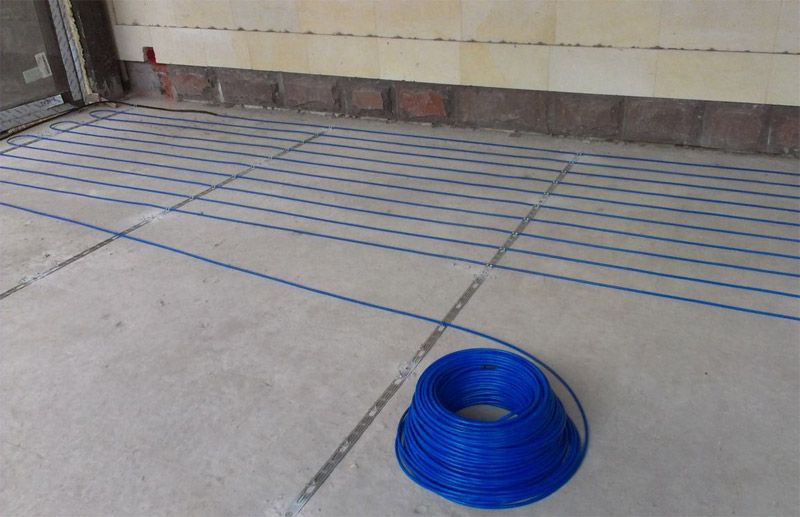
A two-core cable consists of two cores (wires) and does not require connection to the network from the other end. It is reliably isolated by the factory coupling. As a result, the installation of a two-core cable is much easier, especially in rooms with a large area.In addition, the electromagnetic field is almost completely absent, which makes it possible to use it in living rooms.
Heating cables also differ in section thickness. Allocate thick (4-5 mm) and thin (2-3 mm). Thick cables require laying under a cement-sand screed with a layer of at least 3-5 cm. Thin cables can be mounted in a layer of tile adhesive, which creates an advantage in installation.
An important parameter of heating cables, which must be taken into account when choosing for a particular room and for a particular installation method, is their power density (per linear meter). So, for a cement screed, it is recommended to purchase a cable with a linear power of 18-22 W / running meter, and for dry laying under the finish coat, 8-12 W / running meter is enough.
More practical to use underfloor heating with a new type of heating cable - self-regulating shielded. Its distinguishing feature and at the same time advantage is that it reduces power consumption when the temperature in the heated room rises. Its plus is that it can be laid directly under the final floor covering, because. local overheating with it is impossible.
Due to their flexibility, cables can be used for laying heating in rooms of various configurations, including complex ones. If you follow the instructions and recommendations from the manufacturer when laying a warm floor, and also operate it correctly, then its service life can reach 50 years.
Heating mats
Heating mats are a logical continuation of the previous type. They look like a grid (silicone, plastic, etc.), into which cable sections are evenly woven.
Laying this floor accompanies a smaller amount of work.This is due to the fact that there is no need to fill the screed. Depending on the power, it can be laid either in a thickened layer of adhesive or under the final floor covering. In both cases, the rise in floor height will be minimal. Most convenient laying of heating mats in rectangular rooms.
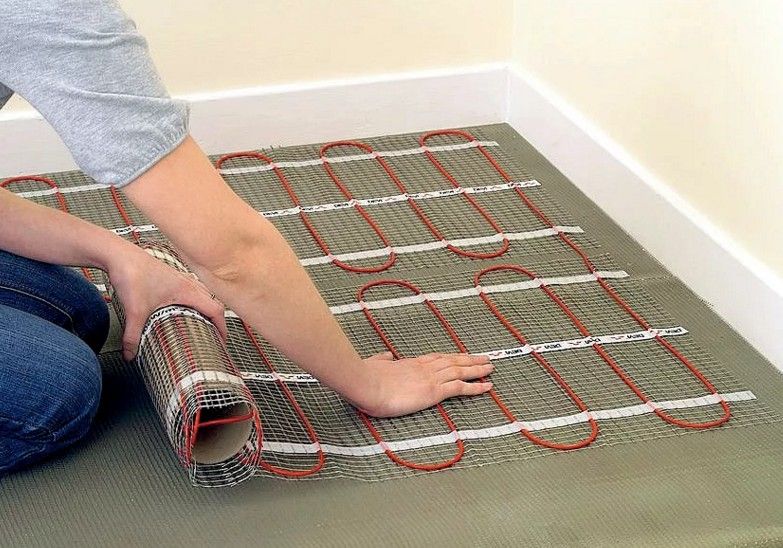
Electric wires in mats can be with one or two cores, they were mentioned above. The specific power of these heating systems is considered not per linear meter, but per square meter. So, when using them as the only source of heating, the required power must be at least 150 W / m2, for secondary heating acceptable 120 W/m2.
All heating mats are equipped with thermostats, the most modern of them are programmable. They allow you to adjust the floor temperature, the time the heating is turned on, when it is really needed.
Film floor heating
This is an innovative type of floor heating, which is also called infrared. It has the highest efficiency in comparison with others.
The mechanism of operation of this floor is radically different: it does not heat itself, but emits infrared radiation, which already heats the walls and floor. In addition, this radiation is only beneficial: it ionizes the air without drying it out, removes strong odors.
The film warm floor has a structure different from the previous types. It is represented by a thin heat-resistant film. The role of heating elements is played by plates made of carbon nanostructure. They are interconnected by copper bars, which are connected to the thermostat with the help of a copper wire, and it is already connected to the 220 V electrical network.
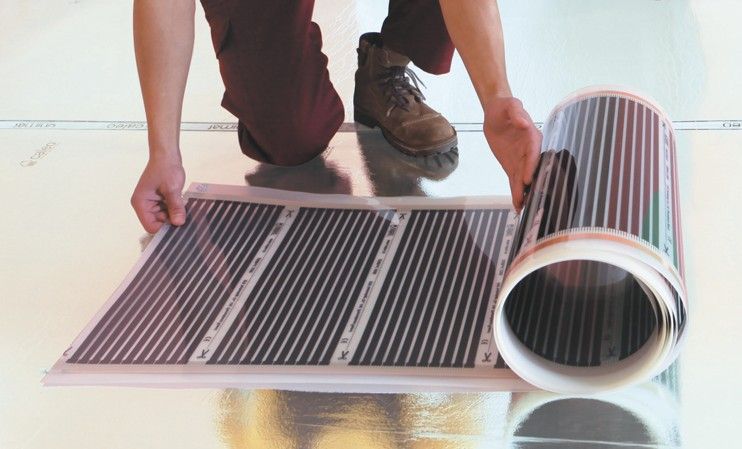
This floor can be installed under any final floor covering.At the same time, it is worth remembering that the film does not like deformations, and it must be laid on a flat, dense surface (for example, plywood sheets with a thickness of at least 1 cm). It is also not advisable to put furniture on it. To increase heat transfer under the infrared film, it is desirable to put thermal insulation. Power varies from 100 to 200 W/m2. Most often, this floor is used for additional heating. Despite all the innovativeness, the period of use is less than that of other types - within 15 years.
What to Consider When Buying Electric Underfloor Heating
Each of its types has its own specifics and installation recommendations, the observance or non-observance of which directly affects the duration of the heating system. So, when buying a warm floor, you need to focus on some points:
- underfloor heating will be used as the sole or secondary source of heat.
The choice of its specific power depends on this. In the first case, it is worth giving preference to models with a specific power index of 150-180 W / m2. In the second case, 110-140 W / m is enough2. This indicator will also vary depending on the purpose of the room. So, for example, a balcony needs more power than a bedroom or bathroom.
- installation method.
Each type has its own subtleties of installation. The cable floor is almost always laid in a screed layer up to 5 cm. The infrared film floor is laid only under the floor covering (not under the tiles).
- the possibility of a common electrical input according to the load.
If your input cable is not designed for this power consumption, it should be replaced and an additional circuit breaker installed.
- installation of an additional residual current device (RCD).
It is an obligatory item when laying a warm floor in rooms with a lot of water (bathroom, kitchen, sauna). Also in rooms with wet processes, it is important to install grounding.
- the possibility of lifting the floor.
The thickest will be the cable floor, because. it requires thorough preparation in the form of a screed, insulation and thermal insulation. The film floor, although very thin in itself, also affects the height of the floor. After all, it requires a base in the form of plywood (at least 10 mm) and heat-reflecting material.
- arrangement of heavy furniture.
This item applies to floors that are not equipped with a self-adjusting power function. When there is a restriction on the output of heat above an underfloor heating element (for example, a furniture leg less than 15 cm), it can overheat and cause a malfunction of the entire system. In addition, when laying a warm floor, you should retreat from the walls and central heating radiators.
Having studied the features of each type, you can begin to review the best electric floors in 2025.
The best cable underfloor heating
SpyHeat Economy SH-300
votes 17
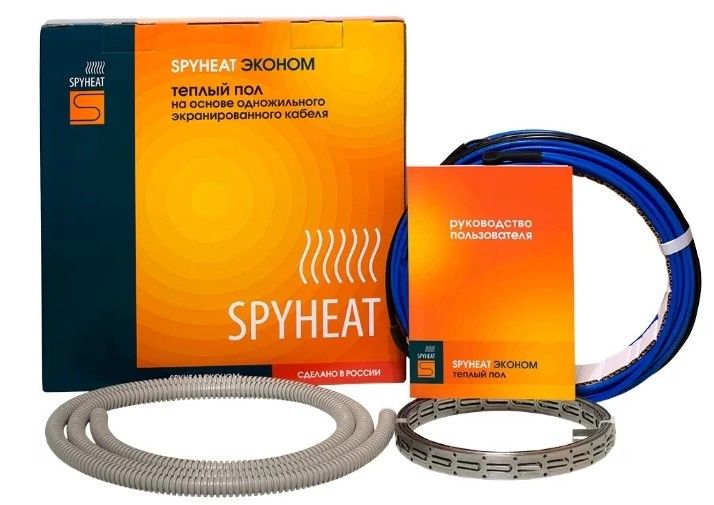
Underfloor heating, which is a single-core shielded heating cable. It has an oval section of 7x4 mm. This underfloor heating model can be used for both additional heating and main heating. In the second case, to obtain full heat, the heating area should not exceed 1.9 m2. It is recommended to use for heating passage rooms, balconies, hallways. Manufacturer's warranty - 17 years. Made in Russia.
The cost is from 1270 rubles.
- corresponds to the declared characteristics;
- with proper use, the service life reaches 50 years.
- creates an electromagnetic field;
- not recommended for heating in living rooms.
Phoenix ASL1P 15960
votes 2
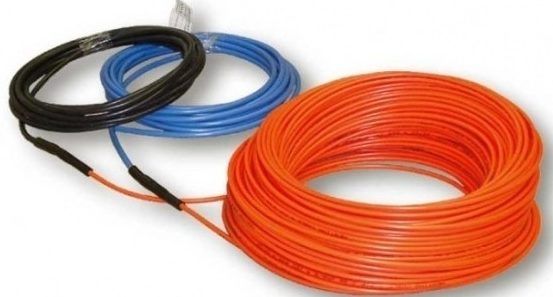
Single-core shielded cable with a cross section of 3-3.4 mm. Laying this warm floor is possible under tiles, self-leveling floor, laminate, etc. Laying in a screed is possible. To obtain the maximum effect, installation can be carried out with a loop pitch of 4 cm. The country of origin is the Czech Republic.
The cost is 6350 rubles.
- laying in damp rooms is possible;
- suitable for direct heating.
- cannot be used for outdoor work.
SpyHeat Classic SHD-15-300
votes 2
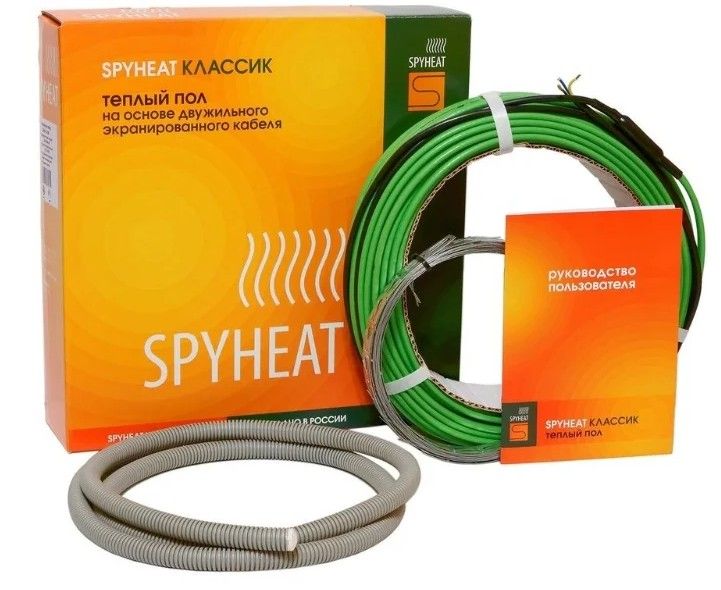
This model is based on a two-core shielded cable with an oval section of 7x4 mm. It is recommended to lay this warm floor under a concrete screed with a thickness of 3 cm or more. the cable can be laid in the shape you need. The step width between the heating elements is 7.5-14 cm. The minimum ambient temperature is not lower than 5°С. Country of origin - Russia.
The cost is from 990 rubles.
- can be laid on walls;
- can be used to heat rooms with high humidity;
- low electromagnetic radiation;
- service life with proper operation up to 50 years.
- dries the air
- you can start using it only after a month (after the screed has completely dried).
Thermo SVK-20
votes 2
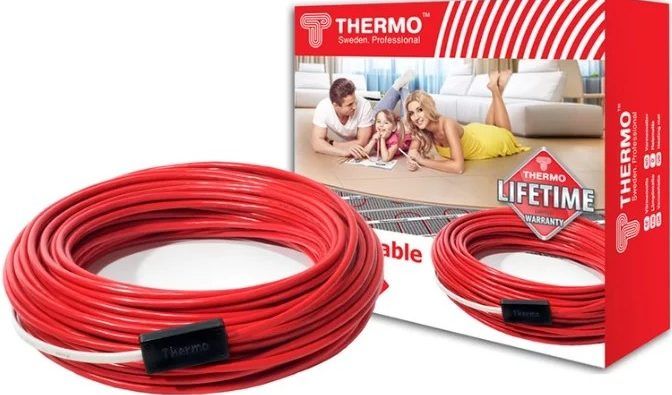
Two-core shielded cable with a cross section of 6.7 mm. Fits into the screed under any finishing floor covering. For greater reliability, the cable is reinforced with fiberglass. The maximum temperature is 90°C. The birthplace of the brand is Sweden.
Cost: 3380 rubles.
- lifetime warranty from the manufacturer;
- minimum service life - 50 years;
- reliable insulation of heating conductors.
- dries the air
- expensive.
DEVI DEVIflex 18T (DTIP-18)
votes 3
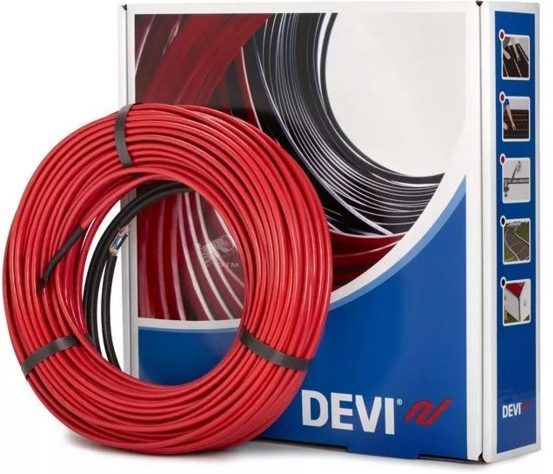
Electric two-core shielded heating cable. The installation is made in a concrete screed with a thickness of 3 cm. It can be used for heating, both indoors and outdoors (on roofs to prevent snow and ice from sticking). The cross section of the cable is 6.9 mm. Suitable for any floor finish. The maximum cable temperature is 65°C. Warranty period - 20 years. Country of origin - Denmark.
Cost: from 4750 rubles.
- refractory outer insulation;
- can be used for outdoor work;
- the minimum bending radius is 4 cm.
- dries the air.
Teplolux 18TLBE2-23
votes 1
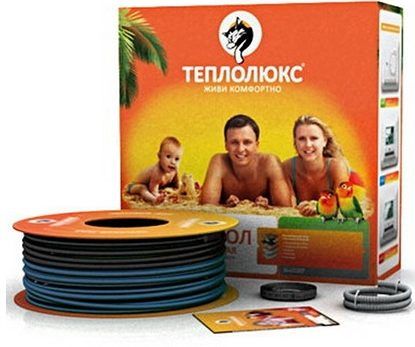
Underfloor heating based on a shielded two-core cable. The specific power of the cable is 18 W/lm, which makes it possible to use it as the main source of heat, as well as a secondary one. It is important to pay attention to the cable laying step. The minimum distance between the turns of the cable is 8 cm. Installation is carried out in a cement-sand screed. Warranty - 25 years. Country of origin - Russia.
Cost: from 2770 rubles.
- the kit includes mounting tape and tube;
- can be used in the anti-icing system.
- dries the air.
Comparison of technical characteristics, considered models of cable underfloor heating
| Model | Length, m | Power consumption, W | Specific power, W/rm | Maximum heating area, sq.m | Cold cable length, m | Price for 1 line meter, rub. |
|---|---|---|---|---|---|---|
| SpyHeat Economy SH-300 | 21 | 300 | 20 | 2,9 | 2 | 60,5 |
| Thermo SVK-20 165W | 8 | 165 | 20 | 1,5 | 3 | 422,8 |
| DEVI DEVIflex 18T (DTIP-18) 395W | 22 | 395 | 18 | 2,8 | 2,3 | 216 |
| Teplolux 18TLBE2-23 420W | 23 | 420 | 18 | 2,9 | 2 | 120,6 |
| Fenix ASL1P 15960 960W | 64 | 960 | 15 | 7,5 | 2,5 | 99,3 |
| SpyHeat Classic SHD-15-300 | 20 | 300 | 15 | 2,6 | 2 | 49,5 |
The best heating mats
ERGERT®MAT EXTRA-150
votes 51

This heating mat differs from similar options in increased reliability, which is ensured by the use of a two-core heating cable, which, in turn, has high-temperature Teflon insulation and continuous shielding of heating and current-conducting cores.
The base in which the cable is fixed is self-adhesive and is a fiberglass mesh.
The kit comes with a corrugated tube with a plug for installing a temperature sensor.
The price depends on the coverage area. The cost for a mat measuring 0.5x1.0 m is 5410 rubles. Information about available sizes and cost can be found on the website of the official manufacturer of the product.
- External and internal high temperature insulation is the highest possible (fluoroplastic PTFE 270°C);
- The minimum thickness of the mat is 2.5 mm;
- Solid armored, braided screen provides protection against mechanical damage and tearing;
- The manufacturer gives a guarantee of 50 years.
- High price.
DEVI DEVIheat 150S (DSVF-150)
votes 14
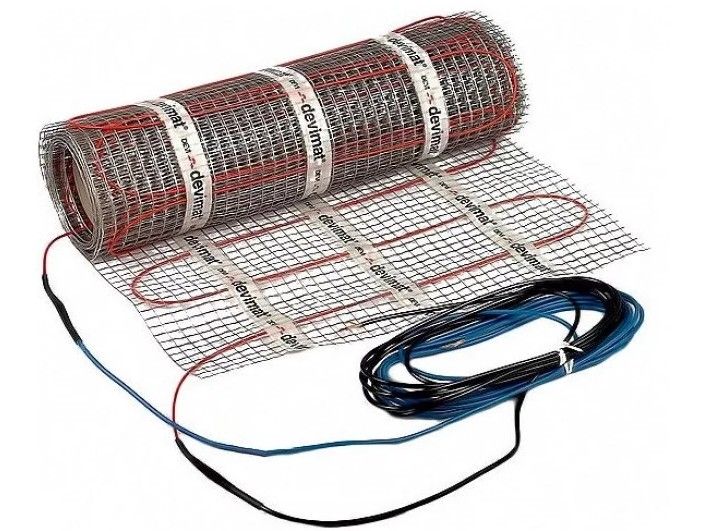
The model is a synthetic mesh, on which a single-core cable is fixed with a certain step. The shielded cable has a cross section of 2.5 mm. Installation under a tile or a laminate in a layer of glue is recommended. It is used for heating passage rooms: bathrooms, hallways, balconies.
Cost: from 4570 rubles.
- practically does not change the height of the floor.
- creates electromagnetic radiation;
- it is necessary to think over the location of the heating mat in advance, becausethe second end must be returned to the beginning of the installation to connect the thermostat.
Teplolux Mini MH200-1.4
votes 6
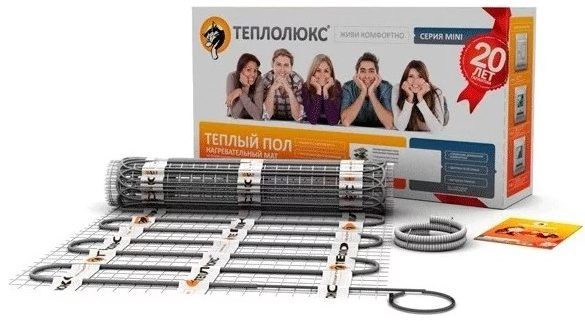
Heating mat based on a single-core shielded cable. The ideal solution for laying under tiles. Made in Russia.
Cost: from 3110 rubles.
- installation on a various basis of a floor is possible;
- does not require grouting.
- creates an electromagnetic field.
Electrolux EEM 2-150-0.5
votes 4
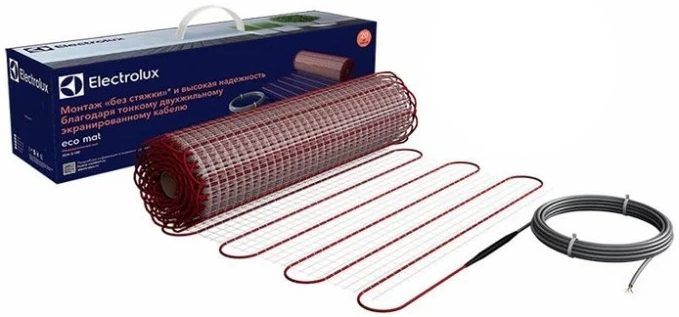
Underfloor heating from Electrolux is a two-core cable fixed on a textile base. The thickness of the mat is 3.9 mm. Perfect for living rooms, bathroom. Warranty period of operation is 20 years. The brand is from Sweden.
Cost: from 1990 rubles.
- can be used in wet areas;
- double insulation of cable cores withstands up to 4000 V breakdown voltage;
- electromagnetic radiation is several times lower than the minimum allowable standards;
- service life: 50 years.
- not found.
Warmstad WSM-300-2.0
votes 7
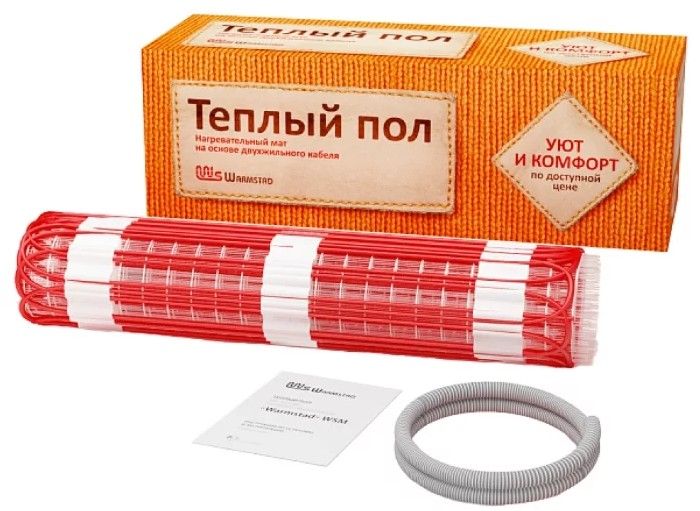
Heating mat 4 mm thick. It is based on a two-core shielded heating cable with one cold end, which greatly facilitates installation in comparison with single-core models. Suitable for laying under tiles, laminate and other flooring. Warranty period - 25 years. Manufacturer - Russia.
Cost: from 1750 rubles.
- The optimum ratio of price and quality;
- can be used to heat any room.
- not found.
TEPLOCOM MND-5.0
votes 1
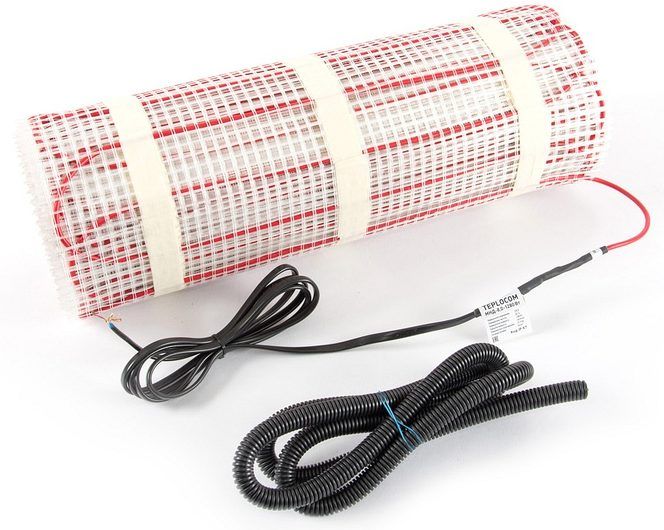
The heating mat consists of a thin two-core cable laid on a fiberglass mesh. The double shield not only protects against electric shock, but also allows electromagnetic radiation to propagate.Laying in a cement-sand screed 2 cm thick or in a layer of tile adhesive is acceptable. Warranty period of use: 16 years. Made in Russia.
Cost: from 4080 rubles.
- recommended for use in rooms in which people are constantly;
- inexpensive.
- the warranty period is shorter than other models.
Comparison of technical characteristics, considered models of heating mats
| Model | Size, cm | Power consumption, W | Specific power, W/sq.m | Heating area (max), sq.m | Cold cable length, m | Price for 1 sq.m, rub. |
|---|---|---|---|---|---|---|
| ERGERT®MAT EXTRA-150 | Various, from 100x50 to 2400x50 | 75-1800, depending on the size | 150 | 12 | 3 | 6590 |
| DEVI DEVIheat 150S (DSVF-150) | 200x50 | 150 | 150 | 1 | 4 | 4576 |
| Teplolux Mini MH200-1.4 | 250x50 | 200 | 140 | 1,4 | 2 | 2494 |
| Electrolux EEM 2-150-0.5 | 100x50 | 82 | 150 | 0,5 | 2 | 3980 |
| Warmstad WSM-300-2.0 | 400x50 | 300 | 150 | 2 | 2 | 876 |
| TEPLOCOM MND-5.0 | 1000x50 | 874 | 160 | 5 | 2 | 816 |
The best film underfloor heating
Caleo PLATINUM 230-0.5 560W
votes 1
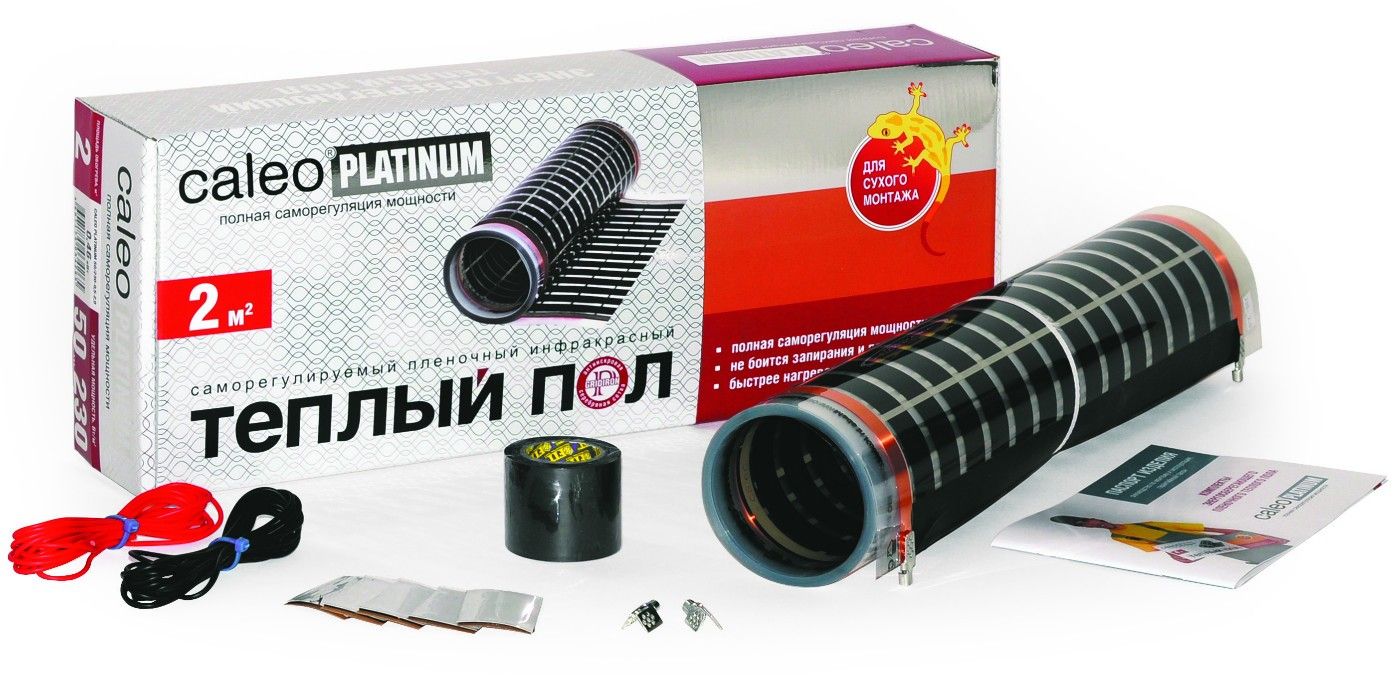
The infrared heat-insulated floor is a thermal film 400x50 cm in size and 0.4 mm thick. A distinctive advantage of this model is self-regulation of power. As the temperature of the film rises, the power consumption starts to drop. Suitable for laying under laminate, linoleum, carpet by dry installation.
The cost is from 5480 rubles.
- has energy-saving properties;
- furniture can be placed on the floor areas under which the film is laid;
- does not dry the air;
- neutralizes unpleasant odors.
- aluminum foil heat reflector cannot be used as a substrate.
Attention! More infrared underfloor heating options hot in 2025 can be found at separate article.
Q-TERM 0.5 m
votes 1
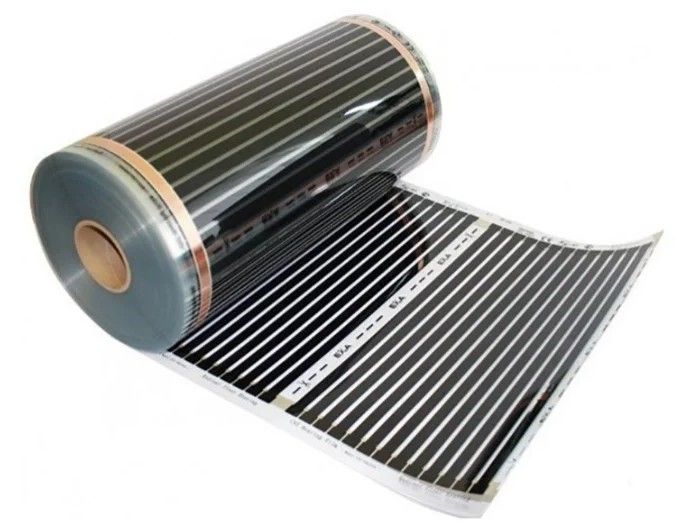
The infrared film floor from Q-TERM is a thermal film 50 cm wide and 0.33 mm thick. The step of cutting the film from the roll is 25 cm. Laying such a floor does not require screed or glue. In addition, Q-TERM infrared film can be used to heat not only the floor, but also the walls. Warranty 15 years. Country of origin - South Korea.
The cost of 1 linear meter - from 190 rubles.
- sold in rolls, which allows you to buy the right amount of film;
- can be transferred to another place;
- ionizes the air;
- does not dry out the air.
- for laying you need a perfectly flat surface.
Caleo GOLD 230-0.5
votes 1
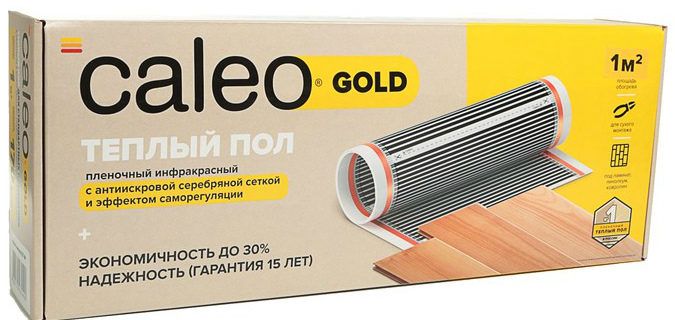
This model of a warm floor is represented by an infrared film 200x50 cm in size and 0.4 mm thick. Specific power is 230 W/m2. It can be used as a source of primary and secondary heating. Under any finishing floor covering. Warranty period: 15 years. Made in Korea.
Cost - from 1830 rubles.
- there is a self-regulation function;
- high fire safety due to anti-spark grid;
- the service life with proper installation and use reaches 50 years.
- requires certain skills for self-installation.
Rexva Xica XM310
votes 2
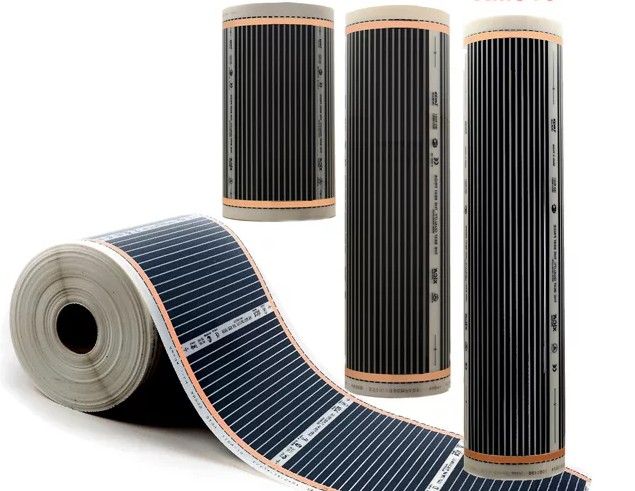
The warm floor of this model is represented by an infrared film 0.34 mm thick and 1 meter wide. The length is cut to the required quantity.
Specific power is 220 W/m2. Laying is done in a dry way under any floor covering. Country of origin - South Korea.
The cost of 1 linear meter - from 370 rubles.
- can be dismantled for further use elsewhere;
- the failure of one section does not affect the performance of the others;
- suitable for heating both residential and commercial premises;
- Large film width speeds up installation over large areas.
- not found.
EASTEC Energy Save PTC
votes 1

A heat-insulated floor on the basis of an infrared film with self-regulation function. Film width - 1 meter, thickness - 0.33 mm, cut-off length. It is used as the main and additional heating in rooms for various purposes. Manufacturer - South Korea.
The cost of 1 linear meter - from 650 rubles.
- quickly and evenly heats the room;
- can be mounted under furniture;
- reduces the heating temperature by a third in the place where the furniture is on the film;
- no electromagnetic field.
- not found.
It's nice not to depend on the central heating, which stops working when it's not quite warm yet. Underfloor heating is comfort and coziness in the house, which everyone can afford.
new entries
Categories
Useful
Popular Articles
-

Top ranking of the best and cheapest scooters up to 50cc in 2025
Views: 131662 -

Rating of the best soundproofing materials for an apartment in 2025
Views: 127700 -

Rating of cheap analogues of expensive medicines for flu and colds for 2025
Views: 124527 -

The best men's sneakers in 2025
Views: 124044 -

The Best Complex Vitamins in 2025
Views: 121948 -

Top ranking of the best smartwatches 2025 - price-quality ratio
Views: 114985 -

The best paint for gray hair - top rating 2025
Views: 113403 -

Ranking of the best wood paints for interior work in 2025
Views: 110329 -

Rating of the best spinning reels in 2025
Views: 105335 -

Ranking of the best sex dolls for men for 2025
Views: 104376 -

Ranking of the best action cameras from China in 2025
Views: 102224 -

The most effective calcium preparations for adults and children in 2025
Views: 102018
